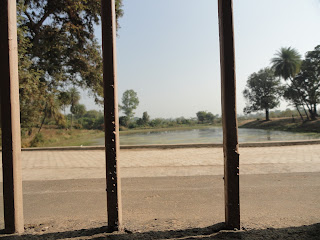In 2011, a last minute travel plan for Christmas holiday didn’t leave me with much choice due to excessive rush in popular destinations. Neither, I had a high budget, as this was a small vacationing. I was based in Delhi Bhopal
In the freezing cold morning of 24th I started for Bhopal
Setting foot at Bhopal Bhopal
Noor Us Sabah
Hotel ‘Noor us Sabah palace’ was my home for the trip. "Noor-Us-Sabah" meaning -"The Light Of Dawn" was built in the 1920's by H.H.Hamid Ullah Khan, for his eldest daughter Begum Abida Sultan. After partition, Begum Abida immigrated to Pakistan Bhopal
 |
| Noor us Sabah |
 |
| View from Hotel |
Udaygiri
I hired a car for all the days I was stationed at Bhopal Bhopal Bhopal
The surroundings transformed to a lost kingdom, once, reached to the hilltop, the kingdom of virtue and pride, the almost forgotten era of Gupta dynasty during the period 4th to 5th A.D. The grand entrance, the motifs and the intricacy and finesse of the artwork made me wonder about the zenith of excellence reached by the artisans of this time. The caves have several statues of Lord Vishnu, as Guptas were known to be follower of Lord Vishnu. There's a statue of Lord Vishnu as the Varaha Avatar (or the Boar Incarnation) and also one of the reclining Lord Vishnu. The statue of Varaha Avatar is very near to the main entrance, showing him coming out of water rescuing Mother Earth (depicted as a woman). The local guide informed that the water body across the road was originally stretched till the cave to create an elusion of Varaha Avatar actually coming out of pataal (Kingdom below the surface of Earth). This very cave with its artistic visionary kept me spellbound. The statue of reclining Lord Vishnu is massive and Awe inspiring. There is a ‘Shiva Lingam’ with face of Lord Shiva in one of the caves which is unique. There are few caves used by Jain saints at the upper level, but not allowed for public viewing due to their dire state.
 |
| On the way to Udaygiri |
 |
| Udaygiri front view |
 |
| Reclining Lord Vishnu |
 |
| Unique 'Shiva Lingam' |
 |
| Water body accross the road |
 |
| Varaha Avatar |
Sanchi Stupa
Finally I started for Sanchi, the world heritage site and sacred pilgrimage place for Buddhists. While reaching Sanchi I noticed a state run Archeological Museum
Emperor Ashoka initially constructed the magnificent Sanchi Stupa during the 3rd Century BCE (Before Common Era). The core of the construction was shaped as a semicircle, which was made over the remnants of Lord Buddha. The Stupa is bordered by Toranas or forms of entrances and every one of the Toranas is a symbol of harmony, affection, bravery, and faith. Other than the main Stupa there are seven more Stupas built in later years. Sri Lanka Government has made a very nice place of worship at the entrance where every year grand celebration takes place.
While returning I visited the museum that made me aware of the sincere efforts of British officers to restore the neglected and forgotten Sanchi Stupa. In 1818 General Taylor made public his 'discovery' of these magnificent ruins. It was Sir John Marshall, Director General of Archaeology in India
 |
| Intricate work |
 |
| Lord Buddha |
 |
| Artistic messages on Toranas |
Raisen Fort
While retuning from Sanchi, which is in Raisen District; driver suggested visiting Raisen fort. The origins of the fort go back to 1200 AD. Up to the 15th century it was under rulers of various Hindu lines, including the Rajputs. In 1543 Sher Shah Suri captured it from Puranmal. Subsequently in 1760 Fiaz Mohammad Khan, the third Nawab of Bhopal, occupied it. As a result, up to India 's independence in 1947, Raisen remained part of the Princely state of Bhopal. Reaching the base of the hill I realised that the the journey to the top has to be on foot by narrow treacherous path. There was no tourist around, but lot of locals mainly lovebirds came for outing. The fort in quite dilapidated state still depicts the grandeur it once commanded. The structure is greatly influenced by Rajput architecture for obvious reason. I decided to avoid going up and view it from the base from different angels.
Next day I headed for Bhojeshwar temple at Bhojpur district. I did not expect much to be left of an 11th century temple weathered through centuries of turmoils. But, I was wrong.
Bhojeshwar temple is the temple of Lord Shiva Bhopal
Bhim Betka
My next destination was Bhim betka, 46 kms south of Bhopal
On my return, I visited the archeological museum of Bhopal
The lakes and Van Vihar
Last day of my stay I visited the lakes ( upper and lower). There are boating facility and lake facing restaurants for spending a pleasant winter afternoon in the bank of upper lake. Not to mention, the graceful swans enhance the beauty of the lakes and entertain kids.
Van Vihar National park at the outskirt of Bhopal
I can not wrap up my travel diary without mentioning the special Kebab and Butter Nun treat at Hotel Jehan Numa palace ‘Under banyan tree’ restaurant.
I went with open mind to a lesser known tourist spot, came back with a treasure of priceless memories of a past to be remembered and to remind.











